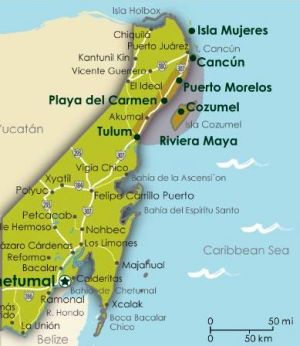Cancun, Mexico - Mexico's tourism industry is like an aging gladiator, having battled swine flu outbreaks, drug-war violence and intense storms over the past decade - including Hurricane Patricia, which sent sunbathers fleeing from the Pacific coast late last month. Now, some local authorities question whether seaweed might strike the fatal blow.
From Barbados to Belize, Cancun to Tulum, a viny brown seaweed known as sargassum has invaded the Caribbean basin this year. Vast floating mats of the algae have washed up and buried beaches.
 |
"Beaches are what we sell to the whole world and what we depend on, directly or indirectly, for all our income," the director general of Cancun's maritime department, Josť Eduardo Mariscal de la Selva, said. "And hotel guests paying $500 a night do not want to open the shades to find paradise matted down under layers of stinking, fly-infested algae."
Since the July invasion, Mexico has launched a Herculean cleanup effort. Along the coast of Quintana Roo state, the government hired 5,000 day laborers in four-hour shifts to rake seaweed from more than 100 miles of beaches.
But it keeps coming back, and scientists are said to be baffled. According to the Washington Post, who quotes professor of optical oceanography at the University of South Florida, Chuanmin Hu, the recent invasion is the largest coverage ever seen in recorded history. Hu has calculated there was nearly 32,000 square kilometers of sargassum floating around in July, compared with 5,956 square kilometers in 2011.
Naval oceanographers have been deployed to track the seaweed. They are also testing a hydraulic suck-pump that has been used successfully in the Dominican Republic.
Meanwhile, an innovative concept to prevent seaweed from reaching Cancun and Riviera Maya beaches has been producing some positive results. Nets were placed into the sea to catch the seaweed before it reached the shore. "The best way to collect sargassum is in the sea, before it sinks," Rear Adm. Fernando Alfonso Angli Rodriguez, the navy's director general for oceanography, said. "We are working on this very hard."
So far, the nets have bee preventing approximately 80% of the kelp from reaching Cancun beaches. Although not a perfect system, authorities have now fought the sargassum to a draw, particularly as the amount washing up has eased up in recent weeks. But farther south, in places such as Akumal, Tulum and Mahahual, visitors who come for Mayan ruins and tropical beaches still have to deal with festering piles of seaweed.
Source: The Washington Post


